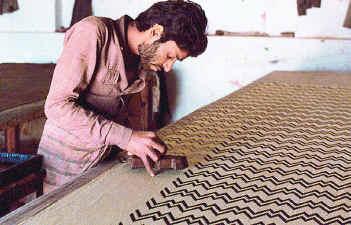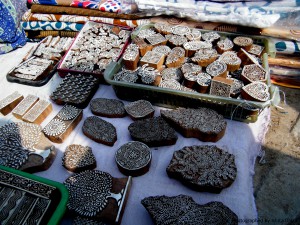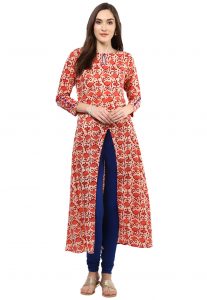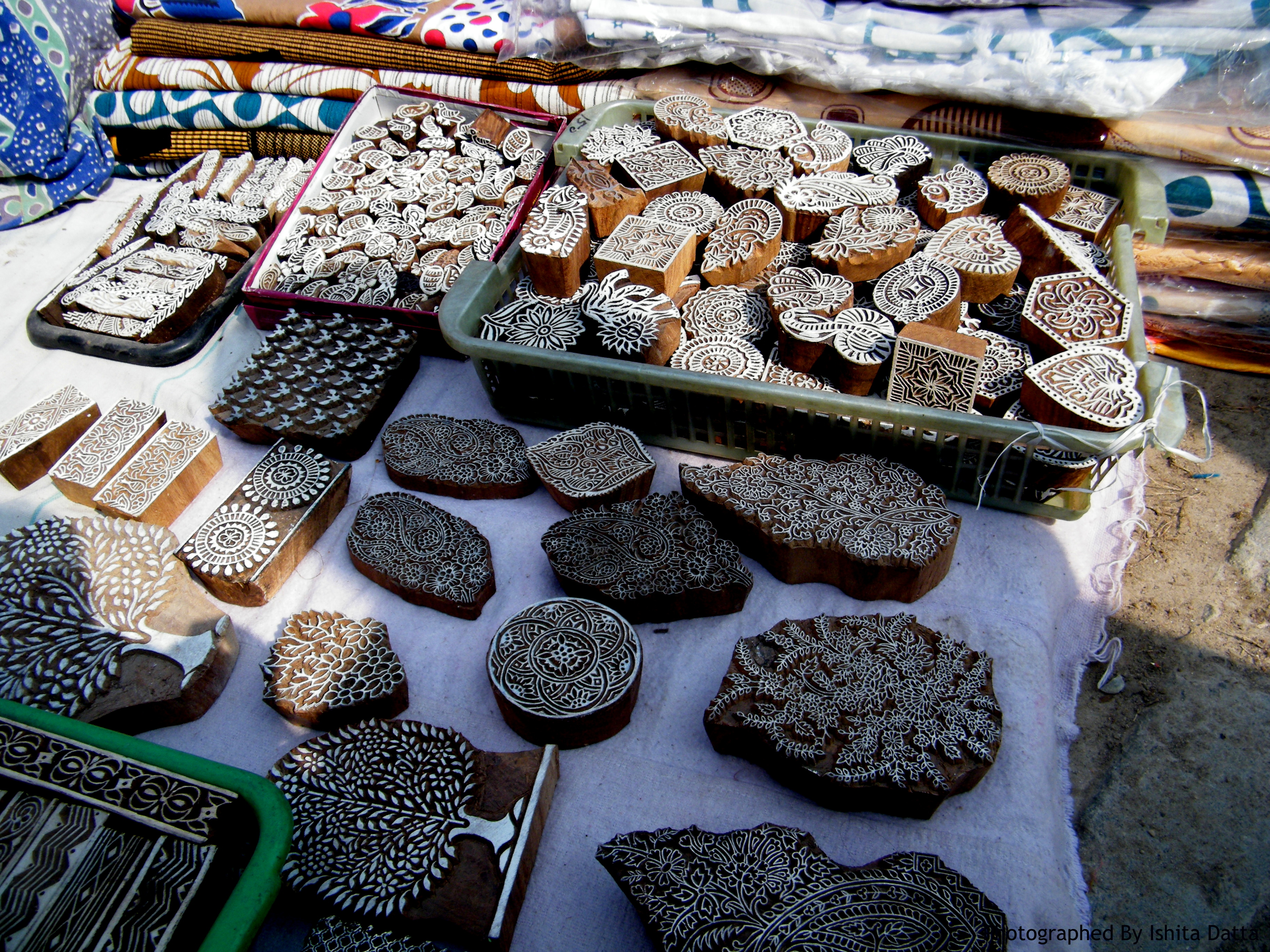
Block Printing
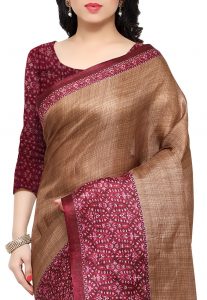
Block Prints on Tussar Silk Saree
Remember, when you were 8 years old, you took out a ladyfinger cut it in two halves dipped it in water color and painted the canvas with the colors of your choice. That is how you can infer hand block prints technique to be like.
The intricate designs that you see printed on the fabric are not designed using a brush. They are patterns printed using wooden blocks. The fine and adorable prints in the shape of flowers, leaves, animals and abstract designs, give a simple cloth an interesting face.
Origin and History
The art of creating block print that is equal and aligned was a requirement felt quite early in the history of the Indian fashion industry. The hand block printing technique was created somewhere as early as 3000 BC. History acquaints us with the art as a tradition followed by the civilization of Mesopotamia. The engraved patterns on the coins used at that time are archaeological examples of the existence of block printing at that time.
The images and block prints that are widely used in East India as a style quotient originated in China. Before this technique came to India, it was a well-established art in the continent of China. The art flourished in the era of maharajas, which happened somewhere around 12th century. However, the practice was conceived long before it got imported to India. Since its inception, the art has been an integral part of the apparel design industry.
Present Day Scenario
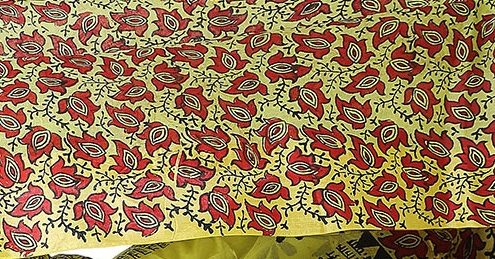
Block Prints
It has been ages since the idea of block printing became a reality. Today, the art of block printing has taken a different route. Block printing has been an elaborate technique since the very beginning. However, it did not have many facets back in time. Hand block printing is one of the most admired arts in the region of Rajasthan. Because of its tremendous demand, the fabrics that have been block printed are exported to other regions in bulk.
Sources of Inspiration
Block printed designs are enamoring. The imprints when impressed on the cloth add an amusing allure to the cloth. Be it bed linen, fabric for apparel or the curtains for your wall, hand block printing is the choicest style for innumerable years in the Indian handloom industry. Unlike the Phoolkari or most other design trends, hand block printing takes its cue from the age old form of arts like Mehendi Designs, and from abstract designs. A wide variety in design and the creative ability of a designer enables a range of patterns varying from simple waves and circles to more elaborate designs. The smaller patterns were at a time known as ‘Chintz’. ‘Buti’, Buta, ‘Jhal’, ‘Bel’ formed the components of each block print.
Faces Behind The Fabric
Unlike most other forms of design, hand block printing is profoundly embossed in the history and culture of almost all Indian states. You have the block printing of Punjab, Block printing of Rajasthan, Block Printing of Gujarat, and Block printing of Andhra, to name a few.
Varieties
The wooden blocks are left to the imagination of the carver who creates intricate patterns of the block. These could be simple geometric formations or more detailed impressions. Depending on the pattern that the artist wants to create on the fabric, the block prints are used on the cloth like block print sarees and several other clothes.
The workers of these states unite to form an industry that is extremely important to Indian and global fashion. While the technique of hand block printing has remained uniform throughout the years and across the states, the variety results from the intelligent and creative usage of blocks to create interesting patterns.
Innovations
From table napkins to canopied light-bulbs, everything today can see a bit of block print on it. Hand block printing, as a technique, has touched every industry and perforated in its roots to become an indispensable trend.
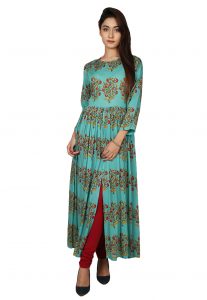
Printed Cotton Front Slit Kurta in Teal Blue
The innovations that have been introduced in the industry are not just an about the varied facets of design. They are also about the shift in technology that the block printing industry has witnessed. When screen printing invaded the industry, it ate up the entire hand block printing industry. Now that people have started understanding the innate differences between block and screen print, both industries flourish in co-existence.
Today, block printing beats the demand for screen prints because of the eco-friendliness that the former has introduced in its practice. The colours and dyes that the industry utilizes are free from any synthetic substance making is an obvious choice of the consumer.
Global Appeal
Hand printing fits miraculously well into the India as well as Western culture. From salwar suits to trendy tops, block prints can be found adorning the neck-lines and hemline of a range of apparels. The global wear-ability of this fabric can be owed to its chic and sophisticated appeal. Moreover, the fact that the maintenance of block print is easy draws consumers from across the globe.
The Future
The future of block printing looks quite impressive from the point where the industry stands today. Hand block printing and screen printing, both have reached a point where further innovation is required in the process of printing. From blocks and screens, it is now time to move on to something more customized, where people can contribute in the designing of the prints and impressions. Just like engraving, where people can customize utilities, hand block printing should be made more customization oriented.
Wearing Block Prints
Experimenting with looks is so much fun with block prints. A long Flared Skirt with a Vest Top, complimented with delicate metallic jewelry gives a chic and modern look. For a traditional look, try a block printed salwar suit with light pearl jewelry.
Block prints are multi-ethnic. Their global and Indian demand stems from the fact that the print industry is an indispensable part of fashion and interiors. Climate is not a constraint for block printing because the fabrics used for block printing could be of any nature.
Maintenance
You don’t have to worry about your block prints much. Some basics like washing them on the reverse, ironing them regularly and keeping them free of stains can easily add value to the life of the block printed fabrics.
Facts And Comparisons
- Hand block printing will cost you five times less than a Phulkari and is five times more popular than it
- The state of Rajasthan is the home of hand block printing
- Hand block printing technique is used in almost every industry related to fashion and interiors
- Use of natural colors has increased the demand for hand block printing by more than 40%
- It is extremely difficult to find out whether a fabric is screen printed or block printed
- During the Mughal era, the block printing technique was a design technique much admired by the imperial class.
References
Categories: Motifs & Embroideries

